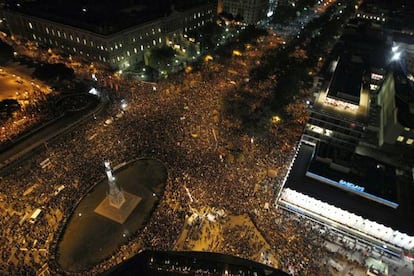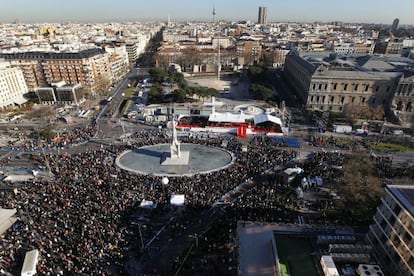Crowd control
Anti-austerity protests have seen huge discrepancies between attendance estimates Does a non-partisan way to gauge numbers exist?

According to Spain's labor unions, no fewer than one million people marched through central Madrid on the evening of the November 14 general strike to protest the austerity cuts being pushed through by the Popular Party government of Mariano Rajoy. But the next day, Cristina Cifuentes, the central government's representative in the Madrid region, put the number at around 35,000.
Cifuentes' laughable underestimate prompted a huge reaction on the social networks, with many people pointing out that when the then-opposition Popular Party (PP) headed protests against the Socialist Party administration's handling of the peace talks with ETA in March 2007 in central Madrid, it had claimed more than two million people turned up.
Clearly, the government of the day has an interest in playing down the number of people prepared to take to the streets to protest against it, and clearly those organizing marches against the government's policies have vested interests in inflating it: but 35,000 versus one million?
"The number of people taking part in protest marches and strikes has never been measured objectively," says Ramón Adell Argilés, a lecturer in Sociology at the UNED distance-learning university, and an expert on the subject. "For the organizers these events are always dubbed 'the biggest in history' while the government always dubs them 'the biggest failure'."
Those numbers
- November 14 anti-austerity march: The central government's delegation in Madrid put the number of marchers at 35,000; the UGT and CCOO unions said one million.
- March 29 first general strike under Rajoy: The unions talked of 900,000 at the demonstration but the official version was 100,000.
- Barcelona's La Diada day: Two million marched for independence, according to the organizers; 1.5 million said city police; 600,000 said the government delegation.
The academic accepts there will always be a discrepancy depending on who makes the calculations, particularly if the government of the day is involved. "In recent years we have seen a growing lack of respect toward protestors, and the figures are clearly biased," he says in relation to the PP-controlled administration in Madrid. He accuses politicians of ignoring protestors: "Their attitude is simply to ignore opposition."
But he also points out that when governments fail to take into account mounting public protests, "there is a danger that marches become violent, as a way of trying to call the authorities' attention." This can also lead those not directly involved in protests, but who may not necessarily support the government, to feel nobody is telling the truth.
"The outcome is that the majority of people end up putting the figure somewhere in between, which is a mistake, because it supposes that both sides are being objective, and that despite their differences, have reliable data," he says. "Both sides assume the public will average out the numbers, when in reality, both sides may have inflated or reduced the estimate."
But in the case of the general strike demonstration, and the discrepancy between the government's figures and those of the labor unions, adding the two estimates together and then halving it clearly offers no solution. Photographs of the march published in the media have led many people to accuse the police and the authorities of lying. "The government is at risk of losing credibility when it is seen to be indulging in propaganda," says Adell.
The underestimate prompted a huge reaction on the social networks
This is not the first time that Cifuentes has been accused of manipulating the numbers. On September 25, when a protest was held in front of Congress, she closed off the streets around the building, creating a cordon manned by 1,300 police officers, but then played down the numbers of protestors, saying that barely 6,000 had showed up.
For their part, the unions have also been accused of inflating their estimates for the number of people who turned out on the evening of the general strike in central Madrid. José Javier Cubillo of the UGT labor union admits his organization's figures are "subject to error." He says the union based its calculations on aerial photographs and the number of people per square meter in the area where the march took place.
"There have been any number of one-million-strong demonstrations," says Adell sarcastically, highlighting the importance of that magic figure.
Cubillo insists it is pointless getting into a debate about exact figures "because this distracts us from the real reasons people are taking to the streets in the first place." He prefers not to comment on Cifuentes' estimate.

"We need to find a way to establish some kind of methodology in the hands of an independent body for calculating these figures: it doesn't matter if the margin of error is the same, because you can always compare the data," says Rafael López of Vaelsys, a company that specializes in video analysis.
He says the best way for calculating figures for marches or demonstrations is based on the number of people per square meter. This means taking an aerial photograph and then dividing the total surface area involved into zones at the height of the event - when the greatest number of people are in attendance - and then assigning a single person to count the number of people in each zone. "We don't recommend using computer technology to calculate the number of people in a march, because other objects in the image can inflate the figure. Computer analysis is fine for events in open spaces. To carry out a computer analysis of a street protest requires breaking the image down into two-meter squares."
A company called Lynce, which recently went out of business, also used video technology to estimate crowd numbers. Its website warned of the "difficulties in counting" when there was cloud cover, placards or in areas with narrow streets. It recommended dividing a photograph up into squares and carrying out a count by hand, saying this was the only way to avoid including bushes, lampposts, rubbish bins or other objects in public places as well as identifying people hidden by banners or placards.
But Adell warns that when two opposing sides have vested interests, there will rarely be agreement over such estimates. One unusual example of concord was the marches held throughout the country the day after the March 11, 2004 bombings at Atocha railway station. The government, the media, the opposition, and the police all agreed that some 11 million people - a quarter of Spain's population - had taken to the streets.
For the organizers these events are always dubbed 'the biggest in history'"
Such occasions are rare, nonetheless. Take the march in Barcelona in September staged by supporters of independence for the region. The organizers put the figure at two million: the police estimated 1.5 million; and the government 600,000.
Writing in Catalan daily La Vanguardia a few days after the demonstration on La Diada day in Barcelona, Llorenç Badiell, the head of the Applied Statistics department at the Autónoma University of Barcelona, explained that the discrepancy between the three figures could be explained depending on how the calculations were based, and that it was possible that the government's figure was correct. "A detailed calculation of the area that was occupied by people and the density of the march show the government's figures to be correct." He pointed out in the article that there are different methods, most of them reliable, and all based on scientific and proven techniques, to calculate the numbers of people in a crowd. In which case, why are there such discrepancies?
The answer is simple, says Adell: vested interests. "People don't go out on to the street for the fun of it; they do so because they are unhappy about something. And governments do not want problems on the streets," he says.
"But the way to stop protests is not to ignore what is going on, or to play it down, but to listen, and to change policy [...] It is unfortunate that governments never see what is going on in the street. That said, governments cannot change their policies every time there is a demonstration."
The majority are not protesting, and aren't interested in making headlines," said Rajoy
The Rajoy government has consistently played down the mounting street protests staged throughout the country against its policies over the past year. "Please allow me, speaking from New York, to point out that the majority of Spaniards are not protesting, and are not interested in making the headlines. They may not be visible, and they are the majority of the 47 million people who live in Spain," said Mariano Rajoy following the protests outside Congress on September 25 after those events had made headlines around the world.
Rajoy's comments alluded to the concept of the silent majority, who presumably support his policies. But the fact that large numbers of people do not take to the streets does not necessarily mean that they back them. "To really assess that, the government would have to organize a demonstration calling on people to come out in support of its policies," says Adell. "Many people do not go on strike because they are afraid of losing their job, but that doesn't mean that they do not support the objectives of a strike."
A demonstration is judged a success on the basis of how many people attend it, and the amount of people that one estimates to have attended depends on whether one supports the demonstration. The problem with this now widely accepted belief is that it has led to the acceptance of the idea that both sides will lie about the figures, which in turn robs any estimate of credibility. There are ways to calculate the amount of people in a protest, but so far, nobody seems to have found a way to apply them without being accused of bias.
Tu suscripción se está usando en otro dispositivo
¿Quieres añadir otro usuario a tu suscripción?
Si continúas leyendo en este dispositivo, no se podrá leer en el otro.
FlechaTu suscripción se está usando en otro dispositivo y solo puedes acceder a EL PAÍS desde un dispositivo a la vez.
Si quieres compartir tu cuenta, cambia tu suscripción a la modalidad Premium, así podrás añadir otro usuario. Cada uno accederá con su propia cuenta de email, lo que os permitirá personalizar vuestra experiencia en EL PAÍS.
¿Tienes una suscripción de empresa? Accede aquí para contratar más cuentas.
En el caso de no saber quién está usando tu cuenta, te recomendamos cambiar tu contraseña aquí.
Si decides continuar compartiendo tu cuenta, este mensaje se mostrará en tu dispositivo y en el de la otra persona que está usando tu cuenta de forma indefinida, afectando a tu experiencia de lectura. Puedes consultar aquí los términos y condiciones de la suscripción digital.
Últimas noticias
Maduro pleads not guilty before the federal court in New York: ‘I am still the president of Venezuela’
A new test can detect Alzheimer’s from a finger prick
UN team enters Sudanese city of El Fasher after paramilitary massacre: ‘It’s like a ghost town’
A recipe for resistance: Indigenous peoples politicize their struggles from the kitchen
Most viewed
- Gilles Lipovetsky: ‘If you want to live better and fall in love, take Prozac, don’t look to philosophy’
- Alain Aspect, Nobel laureate in physics: ‘Einstein was so smart that he would have had to recognize quantum entanglement’
- Alvin Hellerstein, a 92-year-old judge appointed by Bill Clinton, to preside over Maduro’s trial in New York
- Maduro’s downfall puts China’s relationship with Venezuela to the test
- Why oil has been at the center of Venezuela-US conflicts for decades








































